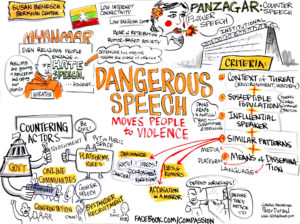What is Dangerous Speech?

Peter Durand / CC BY-NC-ND 2.0 / Watch the talk that inspired this drawing
Dangerous Speech is any form of expression (speech, text, or images) that can increase the risk that its audience will condone or participate in violence against members of another group. Susan Benesch coined this term (and founded the Dangerous Speech Project) after observing that fear-inducing, divisive rhetoric rises steadily before outbreaks of mass violence and that it is often uncannily similar, even in different countries, cultures, and historical periods. We call these rhetorical similarities ‘hallmarks’ of Dangerous Speech. One of them is dehumanization, or referring to people as insects, despised animals, bacteria, or cancer. This can make violence seem acceptable: if people seem like cockroaches or microbes, it’s okay to get rid of them.
Another hallmark is to tell people that they face a mortal threat from a disfavored or minority group, which makes violence seem not just acceptable, but necessary. This hallmark has been dubbed ‘accusation in a mirror’ because it asserts that violence would come from the opposite side – from those who are actually the would-be victims of violence. How can one know which speech is dangerous? One must make an educated, systematic guess. Dangerous Speech cannot be identified solely by the hallmarks or by any aspect of its content, since its capacity to inspire violence depends so much on its context – on who spreads it, how, to whom, and in what social and historical context.
We have developed a test for dangerousness based on the message itself and four related elements: Speaker, Audience, Context, and Medium. These are known as the Dangerous Speech Framework and their elements are described in a bit more detail below.
Message
Dangerous Speech often contains ‘hallmarks’ such as dehumanization or ‘accusation in a mirror.’ Another example of a hallmark is to portray the target group as violating the purity of the in-group, making violence a necessary method of preserving one’s identity. Some Dangerous Speech never makes direct reference to the target group. Instead, it describes members of the in-group either as traitors for being to sympathetic to the other group or as good virtuous in-group members, for example because they express their hatred of the other group.
Speaker
Some speakers are more influential than others, and they are therefore more capable of compelling a group to violence. Influence may stem from their status as political, religious, or cultural leaders, or they may gain influence from their natural charisma. The speaker can be anonymous, and in some cases that can make the speaker more influential.
Audience
When an audience is already ‘primed’ for violence, they will be more easily swayed by Dangerous Speech. A primed audience might be one that is already fearful of other groups, one that has longstanding and unresolved trauma, or one that lacks ties to other social groups – especially the target group. When Dangerous Speech is delivered to an audience that is not susceptible, it is unlikely to lead to violence.
Context
The context consists of the social, historical, and political environment in which speech reaches its audience. Aspects of the context that are conducive to Dangerous Speech include longstanding competition over resources, previous episodes of violence, difficult living conditions, an ongoing war, etc.
Medium
The medium, or means of dissemination, can make speech more dangerous if it possesses its own influence. For example, a medium that is the audience’s only or primary source of information is likely to have significant influence over that audience. Mediums with influence may be a popular newspaper, a particular language, or a type of communication technology – for example, radio, television, or the Internet.
Countering Dangerous Speech
Violence may be prevented by interfering with Dangerous Speech in any of several ways: inhibiting the speech, limiting its dissemination, undermining the credibility of the speaker, or ‘inoculating’ the audience against the speech so that they are less easily influenced by it. Such efforts must not infringe upon freedom of speech since that is a fundamental right – and when people are prevented from expressing their grievances, they are less likely to resolve them peacefully and more likely to resort to violence. For more information on some methods of countering Dangerous Speech, please see our page on counterspeech.
Genocide in 100 Seconds – From Radio La Benevolencija
